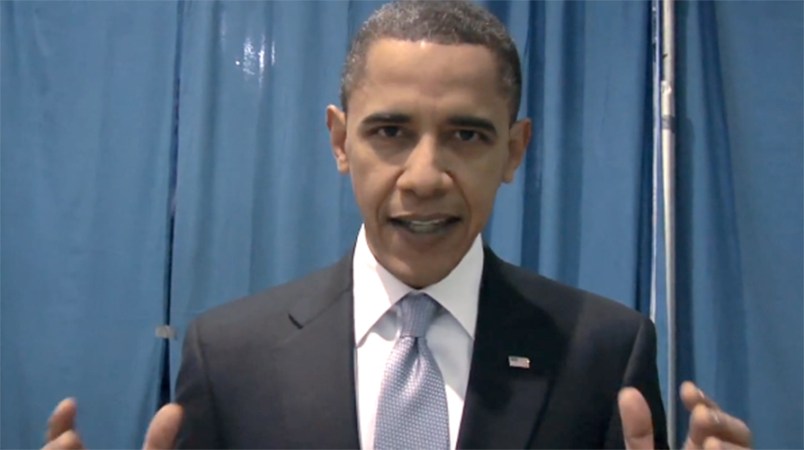Barring some unexpected and dramatic twist, come Monday the country will still be hurtling towards a potentially calamitous default on its national debt.
The only real development heading into the weekend was symbolic. Boehner agreed that the House will vote to raise the debt limit — but only as part of a broader bill that would slash spending dramatically, institute a cap on federal expenditures, and call for a vote on a radical Constitutional amendment requiring balanced federal budgets and making tax increases functionally impossible. This plan is DOA in the Senate. But in transactional terms, it’s meant to appease conservatives who probably won’t vote to raise the debt limit under bipartisan circumstances.
Still, Congress has to actually raise the debt limit, and there are four possible avenues to getting that done on the table right now. Here’s a description of each, in reverse order of likelihood.
The Grand Bargain
This is the $4 trillion deficit-reduction framework President Obama proposed, John Boehner entertained, and Eric Cantor basically scuttled. As far as truly restoring gravity to the country’s fiscal outlook, it’s the only option that would really accomplish that.
But although the White House infuriated many Congressional Dems by ceding to Republican demands for slashing entitlements, it demanded “balance” through fresh — and fairly light — tax revenue.
That proved too much for the GOP. Boehner balked last weekend in the face of severe blowback from his caucus. That was not for lack of trying on Obama’s part — he made clear in his Friday press conference that he’d be open to further means-testing of Medicare, and is reportedly prepared to entertain a higher Medicare eligibility age, and Social Security benefit cuts as well, if Republicans will agree to about $1 trillion in new revenues. Which they’re not.
The Less-Grand Bargain
One of President Obama’s main goals in this fight is to take the debt limit issue off the table for the rest of his first term, so we’re not faced with a similar default crisis in the near future, when we’re much, much closer to election day. Treasury officials say that will require Congress to give Obama about $2.4 trillion in new borrowing authority before August 2. But Republicans arbitrarily insist that every penny of new borrowing authority be matched with a penny of deficit reduction over the next decade. Obama says he’s willing to go there, but not if the plan is comprised entirely of spending cuts. “If you’re trying to get to $2.4 trillion without any revenue then you are effectively gutting a whole bunch of … domestic spending and it is going to be too burdensome and not gonna be something I would support,” Obama said at his Friday press conference. It doesn’t really look like Republicans are gonna blink on that score.
Le Petite Deal
Congressional leaders and President Obama say they’ve identified about $1.5 trillion in spending cuts that are basically “agreed to.” These wouldn’t be enough to make future deficits sustainable, and yet would carve deeply into crucial social programs. Per Obama: “[W]e’ve identified over a trillion dollars in discretionary cuts in both defense and domestic spending. That’s hard to do. That requires essentially that you freeze spending – and when i say freeze, that means you’re not getting inflation so that these are programatic cuts that over the course of ten years, you’d be looking at a potentially 10% cut in domestic spending.” No small concessions. But if Republicans stick to their guns on the dollar-for-dollar standard, that would kick the next debt limit fight right up against the election. And nobody wants that. Obama has threatened to veto any short-term debt limit hike — but he didn’t define “short-term” beyond saying that 90 days or less would be unsatisfactory. But a full year? He’d be hard-pressed to veto that.
The McConnell-Reid Plan
As I reported here, Senate Minority Leader Mitch McConnell’s (R-KY) escape hatch plan to give Obama the authority raise the debt limit — with no spending cuts, but with high political cost — has morphed a bit. Now he and Majority Leader Harry Reid are talking about raising the debt limit, potentially into 2013, by mixing the spending cuts in “Le Petite Deal” with a commitment to convene a Congressional committee tasked with cutting trillions from the deficit — including from entitlement programs. If the panel passed such a plan, the legislation would be guaranteed votes in the House and Senate before year’s end.
The exact contours of the McConnell-Reid plan are still being worked out, but it’s the only proposal out there that would give everybody the cover they think they need, and result in the spending cuts both parties say they want. But it would either require Republicans to relent on the dollar-for-dollar standard, or else a bit of choreography: The cuts, aides say, could be paired with a procedural mechanism that would also allow Republicans to vote to block a higher debt limit. But Obama would be able to veto that move, thus assuring that (a) spending gets cut, (b) Republicans claim to have opposed raising the debt limit, (c) Democrats claim to have voted for deficit reduction, and (d) the country avoids default….at a price unknown.










